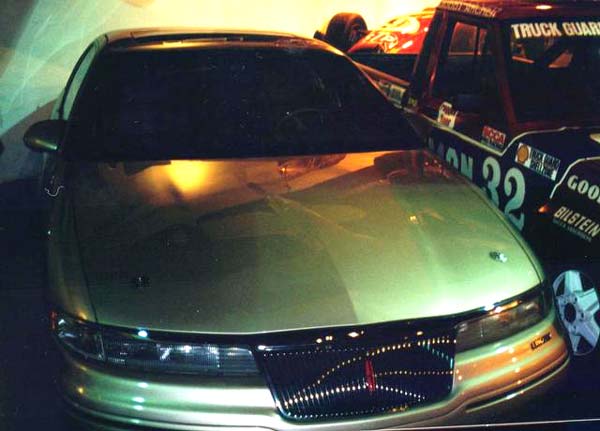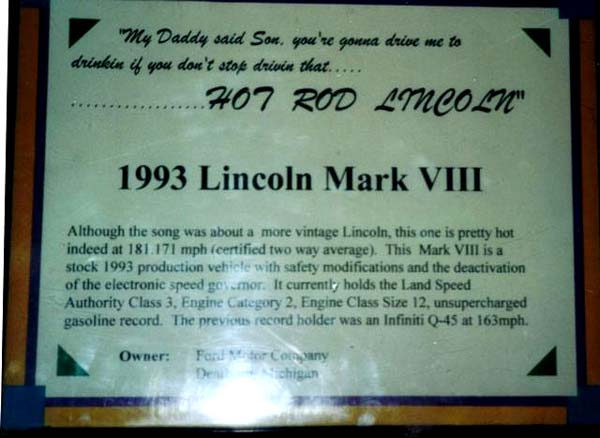
Ford Motor Company was different back then (1992 time
frame) than it is now. There is no way that what took
place and what was approved then could take place today.
I do not know why we decided to run a car at Bonneville,
probably because we ran a Super Coupe out there. I do
know that the manager for the program, Jim Kennedy, was
behind the whole idea and supported the running of the
car. Even though Jim and I didn’t agree on a lot of
things, and I don’t think he ever liked me, he was good
for the car line. He had a vision and tried to fulfill
that vision.
Now with the into, I’ll get onto the details.
Once it was decided that we would run the car at
Bonneville everyone was told to “optimize” their given
subsystem (engine, transmission, axle, suspension, aero,
etc.).
The engine itself was truly a production Mark 8 engine
that was just blueprinted. It had no cats and a dual
exhaust. It was ran on dyno prior to installing it in
the car and made 290-295 HP. It was truly a stock
engine. There wasn’t enough time to put together a
highly modified engine. We started working on this
program about 2 months before the trials in Utah.
The transmission was stock but we did search for
rotating parts that had no imbalance and no run out on
the shafts. Then we built the transmission with high
clearance on the clutches and bands that would not be
applied during the 3rd gear runs.
The axle was changed to a 2.47 axle. We wanted to run in
3rd gear to have higher transmission efficiency. Anytime
you have to turn a gear set, you are giving up power.
Third gear is direct drive and you are not spinning any
gears. So we figured we needed a 2.47 axle to run in 3rd
gear.
The air suspension, which normally lowers the car about
20 mm when you get above a speed, was set to lower the
car another 25 mm so the car would drop almost 2” from
it’s static ride height.
Aside from this, the only other changes to the car
itself were removed rear brakes (for less drag), removed
side view mirrors, some fabricated “belly pans” for
under the car and some kind of air deflector behind the
grill, and the skinny Bonneville tires. (Of course the
car had a roll cage and a two-piece driveshaft).
So now the car is built. But, Jim Kennedy says that we
are not going to Bonneville unless we know for sure that
we can capture the record for the class that it was
going to run in. He said that we need to take the car
out to Ford’s Michigan Proving Grounds in Romeo Michigan
and run the car on the 5-mile oval. If it doesn’t go at
least 175mph at MPG, we are not going to Bonneville. You
would think that a Z rated tire would be OK to run on
those speeds. After talking to Goodyear, they said they
wouldn’t run the regular Z rated tire on that car at
those speeds, we ended up putting Corvette tires on it,
the Goodyear GSC’s, it was the only tire that they would
guarantee on that car at those speeds on the asphalt
track. So, we all go to MPG and they shut down the
high-speed track and run the car backwards (counter
clockwise) on the track. We stood, with a radar gun
about ¾’s of the way down one of the straightaway. The
first lap was only in the mid 150 mph range, a little
disappointing. The next two laps had peak MPH’s of about
168. But, there was hope; the man operating the radar
gun said he was sure his gun was off by 6-8 mph. So, add
that to 168 and we have enough speed to send the car out
west. (I really don’t believe his gun was off, but we
really didn’t care, he said the car was at least in the
mid 170’s and that was good enough for us).
So now we are at Bonneville with the car. The altitude
of the Salt Flats is about 4300 ft above sea level. That
means our 290 HP motor would only make about 255-260 HP
at the flats due to the loss of air density. But the
wind drag is also reduced due to the lower density of
the air. We rented an Aerostar chase vehicle for the
car. We had an entire semi trailer filled with tools and
stuff that we think we may need. The trailer was really
nice, on the side is said, “Lincoln, what a luxury car
should be” and had the Lincoln emblem next to the
phrase.
For some kind of liability reasons, no one from Ford
could actually drive the car during record runs or
attempts. So, they talked to the guy that drove the
Super Coupe, Holly Hedrich, and he agreed to drive the
car for us. Holly was a unique person to say the least.
So, the first run in the car will be just the way it ran
at MPG, the GSC tires, with side view mirrors and with
rear brakes. Now at Bonneville you can start your run
for the timed mile at two different points. There is the
“short course” which is, if I remember correctly, a
two-mile head start to the timed mile, and then there is
the long course where you get about a 4-mile head start.
The difference between the two has to do with what
record you are shooting for and that particular
sanctioning body’s rules. We started the first run on
the short course. One of the guys that was there when
Holly ran the T-Bird told me this; He’s a good driver
but he’ll never make a full pass on the first run. He’ll
come back and say there was something wrong with the car
and that’s why he lifted in the middle of the timed
mile. Well guess what, that is exactly what happened. He
brought the car to the pits and said it wasn’t running
right. Well, little did he know that we had the data
logging equipment in the car and monitored pretty much
every EEC parameter that was relevant for what we were
doing. Myself and one other guy looked over the data and
there was absolutely nothing wrong with the car.
So, without a change, off he goes on the second run.
This time the car runs in the mid to high 160’s, pretty
much what it ran at MPG. With Jim Kennedy coming in the
next day, we needed to find some speed or face an
irritated manager.
So, this time we put the skinny tires on it pulled the
mirrors off and went to the short course starting line.
The car ran in the low 170’s, which was good, but we
really wanted a 180 MPH run. Well, when going over the
data from the run, we realized that the car was still
accelerating at the end of the timed mile. Now, it
wasn’t accelerating really fast, but it was still
accelerating. So, after talking to our guys and them
talking to the sanctioning body, we found out we can run
the long course and still qualify for the record we were
shooting for. So, we lined the car up at the start of
the long course, which was about 100 yards from I-80,
and ran the car. This time it ran somewhere around 178
mph. We ran out of time to re-run the car to back up
that speed, if I recall, there was an issue with the
track. You must run the other direction within an hour
of the previous run.
So, this time we pulled the rear brakes off and went
back to the long course. It was starting to cool off
some since it was getting later in the day, we knew that
would help. The car finally crossed the 180 MPH mark,
running a 180.794. This time we knew we had to get it
turned around and back in less than an hour. We made the
trip to the other end of the track in our Aerostar, and
then looked over the data from the run. The oils were
hot. The transmission was over 250F; the engine oil was
over 275F. I looked at the other calibrator that was
there with me and we agreed, send it back down the
track. The oil is hot, hot oil is thin oil, less
parasitic drag. Also, it was starting to get kind of
dark and cool. This time the car ran 182.694 on it’s
one-way pass for a two way average of 181.717 MPH. We
reached our goal, and only after one day, we still had a
second day. I remember that they announced the speeds
over an AM radio channel. And, after that second pass of
182.694 MPH, the announcer said, before telling the
speed, that there were going to be a bunch of happy Ford
engineers out there. There sure were.
The second day should have been a disappointment, but
after capturing the record on Saturday, there were no
disappointments. We tried a few things to make the car
faster. We lowered the car more, via the air suspension,
it didn’t work. In fact, everything we did on Sunday did
nothing but slow the car down. We successfully took our
183 MPH car and made it run in the low 170’s. But it
didn’t matter; we accomplished what we set out to do.
So, now it’s time to pack up, take a few photos and head
home. Remember the nice semi trailer we had that said
“Lincoln, What a luxury car should be!” Well, we got
some white shoe polish and wrote after that phrase
“fast, 182.694 MPH”. You can see that in the picture.
The truck driver drove all the way home with that on the
side.
Probably the saddest thing of all this is that the
Lincoln “brass” was really kind of upset with what went
on. They did not want Lincoln to have a “racy” image and
refused to use any of what we did out at Bonneville in
advertising.
It was one of the best times I had working at Ford Motor
Company.
By Jerry "JW" Wroblewski
Photos by David "Sleeper" Hogan



![]()











